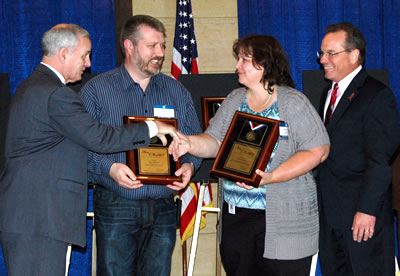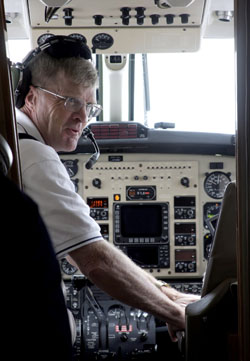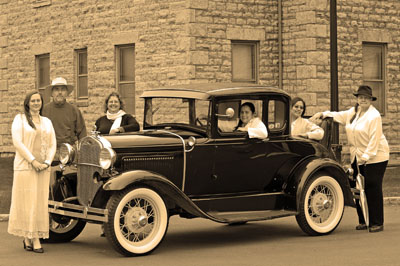 |
|

|
 |
TABLE of CONTENTS
 |
More than two dozen employees receive “Heroes of MnDOT” awards |
By Libby Schultz

At left, Gov. Mark Dayton presents Troy Hollasch and Patty Eckdahl, District 6, with Heroes of MnDOT awards. Deputy Commissioner Bernie Arseneau looks on. Photo by Libby Schultz |
Twenty-five MnDOT employees from around the state received awards for efforts that went beyond the call of duty at the second annual Heroes of MnDOT event April 25. Gov. Mark Dayton, Commissioner Tom Sorel and Deputy Commissioner Bernie Arseneau presented the awards in a ceremony held in the State Capitol rotunda.
“The purpose of this program is to acknowledge employees who have acted courageously or provided meritorious service in response to extraordinary or dangerous circumstances,” Sorel said. “I believe it is important to have such a program, because when our employees carry out these acts, I think we should pause to honor their fortitude and commitment.
“Their heroism and meritorious service reflect great credit not only upon this year’s honorees, but also upon MnDOT. This is something a world class organization does.”
The 10 individuals who received honors are:
- Mike Bukvich, Sue Fagan and Michael Hedlund, District 1 – For their compassion and quick thinking that saved the life of a co-worker in April 2011.
- Leo Fernholz, District 4 – For decisive actions and emergency response that saved the life of a contractor in May 2011.
- Charles T. Larson Jr., District 4 – For emergency assistance that enabled an ambulance-born baby and his mother to reach hospital care amidst blizzard conditions in March 2011.
- Curt Broughten and Thomas A. Johnson, District 6 – For quick thinking and emergency response that saved the life of a crash victim in February 2011.
- Patty Eckdahl, District 6 – For care and compassion for a MnDOT employee’s family in the aftermath of a snowplow crash in January 2012.
- Troy Hollasch, District 6 – For speedy response and safety expertise in the aftermath of a snowplow crash in January 2012.
- Nicholas Vars, Metro District – For decisive actions that brought quick emergency response to a fire in March 2011.
The Regional Transportation Management Center freeway operations dispatchers—Todd Fairbanks, Ken Gilman, John McClellan, Mary Meinert, Tom Shields and Don Zenanko—also received recognition for their daily contributions to traveler safety through their skill in managing freeway incidents and providing essential traveler information.
In addition, the 2012 Heroes of MnDOT list includes the men and women who regularly work in harm’s way to help deliver MnDOT’s construction projects. These “Hard Hat Heroes” were represented by nine individuals who picked up awards on behalf of each district and the Office of Materials and Road Research:
- Tom Lund–District 1
- Corey Johnson–District 2
- Joe Cameron–District 3
- Sverre Rostad–District 4
- John Peterson–Metro District
- Aaron Henderson–District 6
- Lonny “Poncho” White–District 7
- Alan Setrum–District 8
- Mike Novotny, Office of Materials and Road Research
The awards ceremony was preceded by a short concert in the Central Office Transportation Building. The MnDOT Chorus sang “America the Beautiful,” “Hero” and “The Wind Beneath My Wings” as a tribute to this year’s honorees.
A video of the event will be posted on iHUB soon. |
 |
|

|
 |
TABLE of CONTENTS
 |
Department to commemorate Workers Memorial Day April 26-30 |
By Chris Krueger

MnDOT will commemorate Workers Memorial Day April 26-30. |
Employees will commemorate Workers Memorial Day with several events throughout the state this week, honoring the fallen workers who died while working on agency construction and maintenance projects. Commemorative events will be held:
Thursday, April 26 – noon-12:30 p.m., District 7/Mankato Headquarters
MnDOT workers will hold an informal gathering that includes brief remarks and remembrances.
District 7 also is holding a fundraiser for Brad Bruegger, a snowplow driver from Wells Truck Station who is recovering from injuries sustained in a collision with a train in January. The event, which is open to the community, will take place Thursday, April 26, from 4:30-7 p.m. at Hooligans, Madison East Center in Mankato.
Friday, April 27 – 9-10 a.m., Golden Valley Truck Station
Commissioner Tom Sorel will join Duane Hendricks, executive vice president of Egan Company. Two employees of Egan Company, who were working on a MnDOT project, were struck and killed by a vehicle in a work zone in Eagan last fall. Representatives from the Minnesota State Patrol and local unions also will participate in the commemoration.
Monday, April 30 – 8:30-10 a.m., Rochester Truck Station
Sorel and Nelrae Succio, District 6 engineer, will lead a short ceremony. Representatives from the Minnesota State Patrol, local unions and elected officials also will participate in the commemoration.
Since 1960, 33 MnDOT employees and 15 private sector contractors have lost their lives on the job while working on state highways.
“The passing of these workers is a tragic reminder of the dangers men and women face while keeping Minnesota’s roads safe for the driving public,” Sorel said. “It is important that we honor all workers who lost their lives on the job by using extra caution in work zones."
MnDOT continues to work closely with other agencies as part of the Toward Zero Deaths initiative to reduce serious crashes through the integrated use of education, engineering, enforcement and emergency medical and trauma services. As part of its efforts, the department will conduct a public education campaign later this year to remind drivers of the needed behavior in work zones to increase safety and reduce fatalities.
For more information on work zone safety, visit www.mndot.gov/workzone. |
 |
|

|
 |
TABLE of CONTENTS
 |
Audit finds safety issues on Hwy 14 between New Ulm to Mankato |
|
A recent MnDOT road safety audit of Hwy 14 from New Ulm to Mankato found a number of safety issues with the corridor and outlined four alternatives to address those problems. The independent audit was conducted from January to March 2012.
“The severity of crashes on Hwy 14 has been extremely troubling to us,” said Jim Swanson, Mankato/District 7 engineer. “We initiated this audit to determine if there were any immediate low-cost measures we can take and to provide guidance for future investments.”
The audit crash analysis indicates that, compared to other two-lane rural roadways, Hwy 14 has about one-third the number of road runoff crashes, but three times as many head-on crashes than the statewide average. The audit also found a large number of vehicles crossing the center line, even though rumble strips and other safety measures like signing and additional lighting were installed in 2008-09.
The audit findings also note many diagonal or skewed intersections that make sightlines difficult at highway crossings. Human factors found in the review include lower-than-average seat belt usage and distracted driving.
Speeds on Hwy 14 were determined to be similar to other rural roadways and average 10 mph above posted speed limits.
To address the head-on crashes, the report introduces four alternatives for consideration that address the center of the roadway. Two recommended alternatives include creating a buffer area by restriping the roadway for errant driver recovery; one would be 4-feet wide and the second would be 12-feet wide and would include turn lanes. The third restriping option is a new design for Minnesota called a two-plus-one road. Motorists would have passing options only in the two-lane sections and a barrier would run down the middle of the road. The fourth alternative is a four-lane divided highway.
The Hwy 14/Hwy 15 intersection in New Ulm, with its curvature, steep grades and a large number of turning vehicles, also was determined a safety issue. The audit recommends this intersection include an all-way stop, a roundabout or an interchange.
MnDOT will complete an analysis of the recommendations, including cost, and look into available funding. The highway improvement recommendations are not low-cost and MnDOT currently does not have funding designated for expanding the entire corridor to a four-lane expressway.
Earlier forecasts of increased traffic on Hwy 14 are not proving true in today’s economy, according to Swanson. The flat traffic volumes combined with flat transportation funding with decreased purchasing power make major investments like four-lane expansions difficult.
However, action to improve driving behaviors on the corridor will be tackled by the multi-agency Toward Zero Deaths program.
MnDOT will continue to meet with the Hwy 14 Partnership in May as part of a new Corridor Investment Management Strategy program that will look at interim options.
To review the entire audit report, visit www.dot.state.mn.us/d7/projects/14newulmtonmankato/. |
 |
|

|
 |
TABLE of CONTENTS
 |
Barry Erickson becomes chief pilot |
|
By Dan McDowell

Barry Erickson, MnDOT's new chief pilot. Photo by Dan McDowell |
Barry Erickson, a MnDOT veteran with more than 25 years of state service, recently accepted a promotion to chief pilot for the Office of Aeronautics.
Erickson became an active pilot in 1972 when he joined the United States Air Force and completed officer and undergraduate pilot training.
Following his active duty, Erickson began flying for Braniff Airlines as a Boeing 727 flight engineer until Braniff went out of business in 1980. Erickson also flew charter operations for Duluth Aviation in Duluth, Minn.
In 1984 he began flying the Beech Bonanza, Beech Baron, the Hawker-Beechcraft KingAir and the Cessna Citation aircraft for MnDOT.
Erickson has amassed more than 10,000 hours of incident/accident free flying and has been recognized numerous times by the Federal Aviation Administration, National Business Aircraft Association and Minnesota Business Aircraft Association for safe flying and excellence in leadership.
"Erickson's leadership and vision will certainly prove valuable to Aeronautics and MnDOT as a whole in the coming years," said Chris Roy, Aeronautics director. "As budgets and needs change he will help to assure we have an effective and efficient flight transportation system available for all state government agencies and approved personnel." |
 |
|

|
 |
TABLE of CONTENTS
 |
Metro District employee eligible for vacation donation |
Emmanuel Taye, Metro District Consultant Services, is now eligible for the state vacation donation program, which allows employees to donate up to 40 hours of vacation per fiscal year for approved recipients who have exhausted their sick and vacation leave due to illness.
Taye, a state employee since July 1996, was recently diagnosed with kidney failure and is currently undergoing dialysis three days a week.
To donate vacation hours, go to the Employee Self Service Web site and click “Other Payroll” and then “Leave Donations.” The site also allows employees to view a list of all state employees eligible for the program and enroll as a recipient.
Related information:
Road to recovery: Vacation donation program eases the pain (Newsline, Nov. 10, 2010)—Read a viewpoint from one MnDOT recipient. |
 |
|

|
 |
TABLE of CONTENTS
 |
Commissioner’s next book discussion set for May 2 |

Scott McBride, Metro District engineer, will lead the Commissioner’s Reading Corner discussion May 2. Photo by Qin Tang |
Employees are invited to attend the latest Commissioner’s Reading Corner discussion Wednesday, May 2, at 1:30 p.m., in the MnDOT Library at Central Office.
Scott McBride, Metro District engineer, will lead a discussion of “The Big Roads,” by Earl Swift.
Employees also can participate virtually via Adobe Connect and should log in as a guest no earlier than 1:15 p.m. All employees are encouraged to attend, even if they have not yet read the book, according to Qin Tang, MnDOT librarian.
This will be the fifth CRC event of the 2012 season.
For more information on the Commissioner’s Reading Corner, visit ihub/readingcorner. Employees with questions can contact Qin Tang at 651-366-3784.
To read an interview featuring McBride’s reaction to the latest book, visit ihub.dot.state.mn.us/readingcorner/interviews.html. |
 |
|

|
 |
TABLE of CONTENTS
 |
New web-based system to manage transportation program, funding data |
By Lisa Yang
The Transportation Investment Management System is scheduled to be in place this May, serving as the new way to maintain and manage the State Transportation Improvement Program as a dynamic, accessible data store.
“TIMS will replace the current manual process of submitting, analyzing and tracking changes to projects and funding data via spreadsheets or separate databases,” said Debra Hipp, TIMS application coordinator. “It will minimize opportunities to misinterpret the STIP due to outdated, point-in-time documents.”
TIMS also can produce an up-to-date electronic STIP document that will include the most current project and funding data available. It will provide real-time snapshots and analysis of the current four-year transportation program and support decision making and management of programs and budgets.
Project data for the 2013-2016 Area Transportation Improvement Programs are currently being entered into TIMS. District and Central Office users will receive training in May on how to use TIMS.
“We are pleased that TIMS is now going into production,” said Brian Gage, transportation planning director. “This is an exciting change in how MnDOT manages our transportation program project and funding information.” |
 |
|

|
 |
TABLE of CONTENTS
 |
Joe Pignato named Real Estate and Policy Development acting assistant director |
By Libby Schultz

Joe Pignato, Real Estate and Policy Development Section acting assistant director, has worked for MnDOT since 1997. Photo by Libby Schultz |
Joe Pignato became the Real Estate and Policy Development Section acting assistant director March 28. He replaced Mike Stensberg, who is now the Office of Land Management acting director.
Pignato has worked for MnDOT since 1997 in several offices and roles, including Consultant Services, Right of Way and Government Affairs. Pignato also has served as West Metro District area engineer. Prior to his MnDOT career, Pignato worked as a consultant engineer for LHB Engineers and Architects, Inc.
“I am looking forward to continuing work with the districts, helping them with right of way acquisitions and providing them with the same services as my predecessors,” Pignato said.
Pignato graduated from North Dakota State University with a bachelor’s degree in civil engineering. |
 |
|

|
 |
TABLE of CONTENTS
 |
Library to host open house for National Library Week |

Library staff pose for photo to commemorate the Minnesota Highways newsletter, the department’s employee newsletter from 1951-1976. From left are Christie Schultz, Jim Byerly, Sheila Hatchell, Karen Neinstadt, Qin Tang and Pam Gonzalez. Photo by David Gonzalez. |
Employees are invited to take a step back in time and celebrate National Library Week at an open house May 3 from 10 a.m. – 3 p.m., in the MnDOT Library at Central Office.
The open house will feature the rollout of the newly digitized Minnesota Highways newsletter, the department’s employee newsletter from 1951-1976.
“These old newsletters are definitely worth a look, even if just for nostalgia,” said Karen Neinstadt, MnDOT Library. “It’s an opportunity to see if you can recognize anyone.”
Visitors will have the opportunity to participate in activities, browse the collection, enjoy treats, reminisce and sign up for a chance to win door prizes.
District employees can participate in the drawings by submitting their name and mailstop to library.dot@state.mn.us anytime from 10 a.m. – 3 p.m. on May 3.
National Library Week is an annual event sponsored every April by the American Library Association, the oldest and largest library association in the world.
“This opportunity allows us to emphasize the importance of library services and staff in the research process and learn about the resources available to help you save time and cut costs in your work,” Neinstadt said.
For more information, contact the library at 651-366-3791 or library.dot@state.mn.us.
|
 |
|

|
 |
TABLE of CONTENTS
 |
On the job: Praveena Pidaparthi keeps up with passenger rail trends |
By Becky Dahlberg

Praveena Pidaparthi oversees the Twin Cities to Milwaukee High-Speed Rail Corridor Program in her role as planning director for the Passenger Rail Office. Photo by Becky Dahlberg |
There’s never a dull moment in MnDOT’s Passenger Rail Office these days. For Praveena Pidaparthi, Passenger Rail planning director, it feels good to be involved in projects that will “pave the way for a new passenger rail system in Minnesota and the nation.”
Pidaparthi joined MnDOT’s Transit Office in January 2009 and moved into the Passenger Rail Office when it was created that summer. She has since helped develop the Minnesota Comprehensive Statewide Passenger and Freight Rail Plan and currently manages the Twin Cities to Milwaukee High-Speed Rail Corridor Program.
Newsline recently sat down with Pidaparthi to find out more about her role with the department.
How does your office help implement the agency’s multimodal strategic vision?
The Passenger Rail Office was formed in 2009 to lead the state of Minnesota’s efforts in the development of a passenger rail network that provides an improved travel option for Minnesotans and connects Minnesota’s regional centers to each other, the Midwest region and the nation. A few of our main tasks include developing a robust intrastate and interstate passenger rail system and maximizing available local, state and federal public and private resources to develop passenger rail improvements. We also work to advance projects incrementally and simultaneously as demand warrants and funding is identified. Additionally, we serve as the state’s technical resource related to passenger rail development.
These fit well into the department’s multimodal strategic vision to be a global leader in transportation, committed to upholding public needs and collaboration with internal and external partners to create a safe, efficient and sustainable transportation system for the future.
What’s a typical day like for you?
A typical day for me involves overseeing a variety of projects. For example, I currently serve as the project manager for the Twin Cities to Milwaukee High-Speed Rail Corridor service-level environmental analysis, evaluating the existing Amtrak Empire Builder route with a no-build alternative to identify the preferred alternative for the corridor. My main duties include consultant oversight and coordination with Federal Railroad Administration staff to make sure the technical analysis is in sync with federal guidelines.
I’m also overseeing a feasibility study in partnership with WisDOT to look at adding a daily train, seven days a week, between the Twin Cities and Chicago at times that complement the existing service times of Amtrak’s Empire Builder train.
I’m also involved in managing the day-to-day activities of the Minnesota Intercity Passenger Rail Transportation Forum, which is a large group of stakeholders who provide key input to the implementation of passenger rail projects in our state.
In partnership with federal and local agencies, I also assist our office staff with the Northern Lights Express Corridor and Zip Rail projects.
What recent challenges have you faced?
A big challenge for our office is finding sustainable funding sources for passenger rail system development, maintenance and operations in Minnesota. During the 2011 shutdown, due to the general fund source of our funding, our office was faced with complete budget cuts by the Legislature. Fortunately, our funding was retained and it was a big relief coming back to work.
Have you noticed any passenger rail trends?
Passenger rail development is constantly evolving. The federal passenger high-speed rail program is 3 years old. In 2009, President Obama put forward his vision for high-speed rail in the United States, and since then, it is becoming more visible at the state and local level as well.
With new technologies, new style of equipment and changing travel patterns, our office is responding as we implement the 20-year vision on the State Rail Plan that provides guidance on passenger rail initiatives and investments in Minnesota.
Do you or a co-worker have an interesting job to share with readers? Click here to send us your ideas, and we’ll contact you for more information.
Recent employee profiles:
|
 |
|

|
 |
TABLE of CONTENTS
 |
Thinking green: MnDOT uses geothermal heat, recycles bridges |
By Bob Filipczak
Earth Day was April 22, so it’s a good time to reflect on how the department is efficiently using resources and conserving both the energy it uses and the infrastructure it is responsible for.
On the energy front, MnDOT’s Building Services Section has been using geothermal heat pump systems to heat several buildings around state, including:
- District 7/Mankato headquarters
- Warren Truck Station
- Silver Bay Truck Station
- Paynesville Truck Station
- Mendota Heights Truck Station
- St. Cloud Travel Information Center
Geothermal heat pump systems are more efficient than traditional heating and cooling systems, according to Glenn Heapy, Building Services mechanical engineer. The systems normally provide a 12- to 15-year payback, while other alternative energy sources like solar and wind have a much longer payback.
The department has five additional systems currently under construction and four still in the design phase.
MnDOT also is going green with its infrastructure, for example, by recycling old bridges.
As part of its charter to preserve historic transportation structures, the department did a review of all bridges and identified a small subset to restore and save. In cooperation with the Minnesota Department of Natural Resources, these historic bridges are being recycled and used on trails for bicyclists and pedestrians.
The department has finished two bridge recycling projects and will soon be starting a third:
- Gateway Trail Iron bridge — The 1873 wrought iron structure has had three resting places—central Minnesota, the North Shore, and now in Grant Township in the northeastern Twin Cities metro area. It is the oldest and rarest bridge on MnDOT’s list. A video about MnDOT’s first bridge recycling project explains the structure’s history.
- Old Shakopee bridge — This bridge was saved by strong public support for preservation. The structure is still in its original spot next to the newly built Hwy 169 bridge, giving bicyclists and pedestrians a way across the Minnesota River.
- Stillwater Lift bridge — Now that President Obama has signed legislation to build the new St. Croix Crossing, the historic Stillwater Lift bridge will be restored, repurposed and recycled. The bridge will connect hiking and biking trails in Wisconsin and Minnesota across the St. Croix River.
|
 |
|

|
 |
TABLE of CONTENTS
 |
Districts raise money for those in need |
By Lisa Yang
Employees pitch in every year to help raise funds or donate items to those in need, and this year, District 3 and District 7 are starting early.
District 3 recently held a silent auction and raised more than $1,000 for the Salvation Army Food Shelf. Employees donated more than 100 items including food, kitchen and gardening supplies, golf clubs, fishing rods, paintings, horseback rides, weekend use of lake homes and pine trees.
The silent auction is an annual event hosted by District 3’s wellness committee in Baxter. The event is held for two days with winning bids announced on the second day.
District 7 will host a fundraiser for Brad Bruegger, Wells Truck Station, whose vehicle was struck by a train while plowing snow in January.
The fundraiser will take place April 26, from 4:30 to 7 p.m., at Hooligans, Madison East Center in Mankato. There will be food, a silent auction and music by Coop & Scheidel. |
 |
|
| |
|



